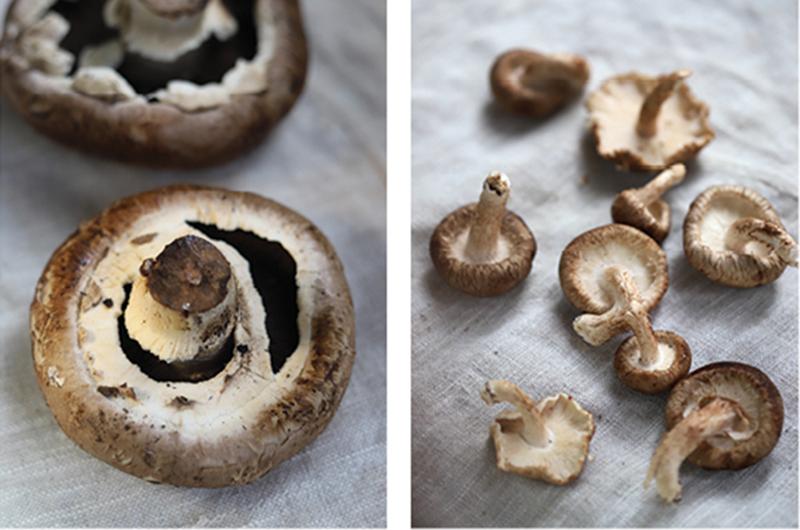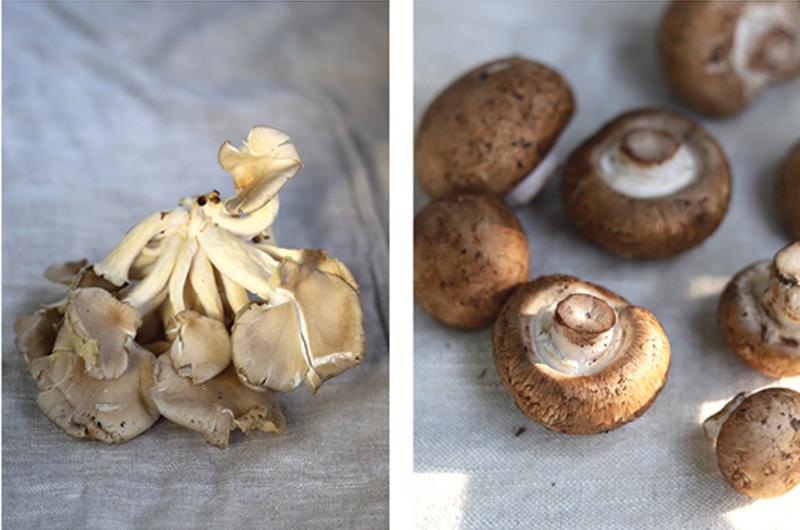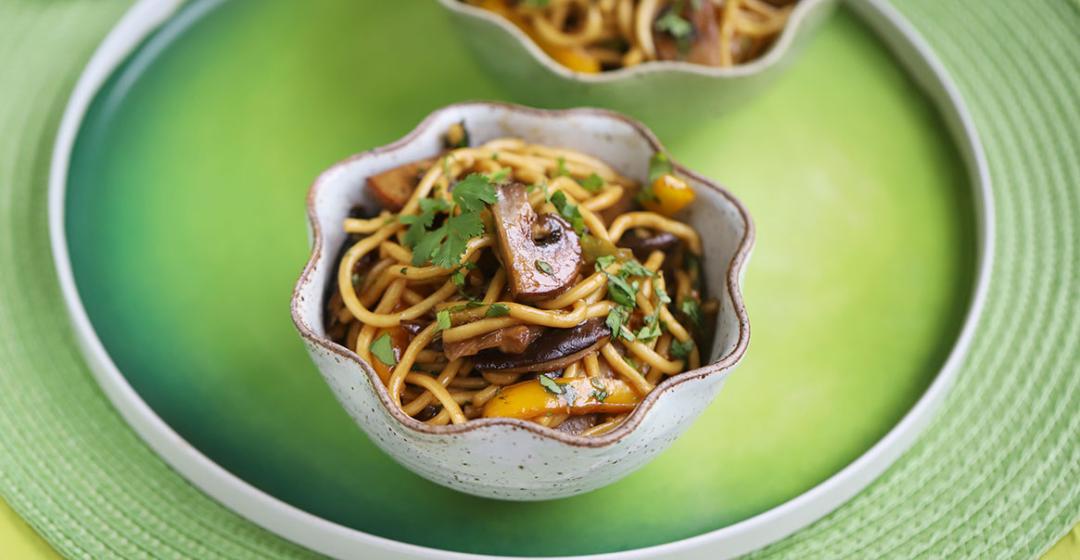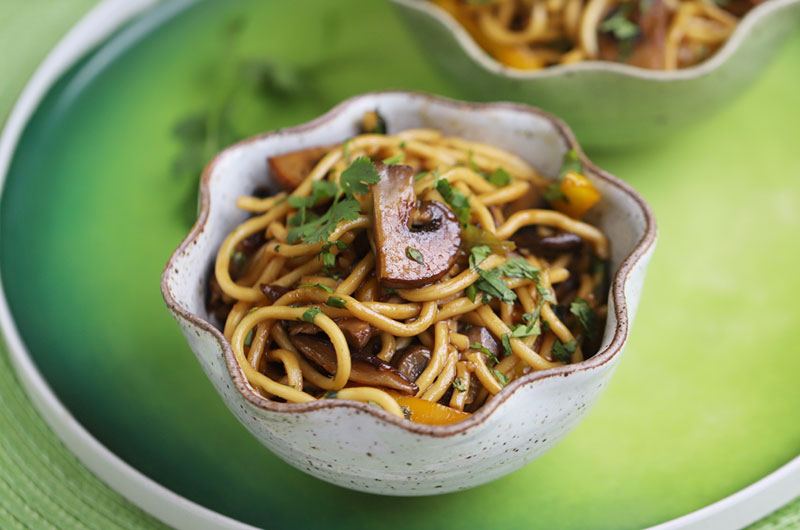This is not an article about magic mushrooms. Or foraged mushrooms. I’m sorry to say I know almost nothing about either of those topics, though I understand both are fun. What I do know a little about is how to cook cultivated mushrooms, what flavors to pair them with, and what kinds of dishes to make with them. I also happen to really like them, so I have self-elected myself your mushroom cheerleader.
I do feel a little bad about the foraging thing – we’ve had dozens of mushrooms pop up in our Vineyard backyard over the last year, most of which I’m sure aren’t edible. But some look distinctly familiar! I’m pretty sure I won’t get my Vineyard local food diploma until I’ve completed foraging training. And yet for now, I do my foraging at local farm stands.
For many years we had a thriving mushroom operation on the Island, and you could find Martha’s Vineyard Mycological shiitakes at the West Tisbury Farmers’ Market and many farm stands. Unfortunately for us, MV Mycological departed for the Hudson Valley this year. On a positive note, North Tabor Farm is still growing an abundance of shiitakes. They’re available at their farm stand through late fall. Beetlebung Farm intermittently has shiitakes and oyster mushrooms from Sugarshack Mushrooms in New Paltz, New York. And Morning Glory always stocks nice creminis and shiitakes from Pennsylvania. You might spot shiitakes at Mermaid Farm as well.
But when I want really big, meaty shiitakes I head to Ghost Island Farm. These fabulous mushrooms come from a farm in Pennsylvania (where a vast majority of American mushrooms are grown). More good news: Ghost Island recently started growing some of their own mushrooms. Late this year, they expect to have golden and pearl oyster mushrooms for sale. Keep your eyes open for those.
Between the farm stands and a regular supply of shiitakes, creminis, portobellos, and oyster mushrooms at Cronig’s Market, you can get friendly with four of my favorite mushrooms. I’m a huge cremini (a.k.a. baby bella) fan. These earthy-tasting mushrooms hold up well in cooking and brown up beautifully. They’re truly versatile ingredients. Portobellos are actually large, mature creminis; they have a dense and meaty texture that requires a little special attention when cooking (more on that in a minute). The flavor of shiitakes is beguiling – almost smoky or even a bit tannic, though in a good way. When cooked until very crisp and brown, they are addictive, to me at least. Oyster mushrooms have a sweet, nutty flavor and a pleasantly bouncy texture that makes them terrific in stir-fries.

So let’s get to the good stuff: cooking delicious mushrooms. If you think you don’t like mushrooms, I’m here to change your mind and erase your bad memories. Because I think the secret to enjoying mushrooms is to cook them well. And by cooking well, I mean browning. The flavor – and texture – of almost every type of mushroom vastly improves when most of its moisture is released and it is allowed to brown up.
Science backs me up on this.
When mushrooms brown, they undergo something called the Maillard reaction, a chemical process that transforms the carbohydrates and amino acids in mushrooms, directly producing the intense flavor compounds that we now recognize as umami. The outward clue is the deep pumpkin spice–orange color the mushrooms take on as they brown and lose moisture.
That moisture – the water that most fresh mushrooms contain – is what trips cooks up. There are two ways to get rid of it. You can cook the moisture off at the start of cooking, using medium or low heat, and the mushrooms will subsequently begin to brown once the liquid has evaporated. Or you can start off with high heat and the mushrooms will begin browning right away. Some moisture and a little bounce will be retained if you opt for this method.
How you cut your mushrooms will also affect how quickly and efficiently they brown. I never slice mushrooms thinly for a sauté or stir-fry as they will just smother each other and prevent browning. Instead I quarter or thickly slice the caps so that I get some meaty heft, good surface area for browning, and a better shape for bouncing around the pan.
Something to be aware of when cooking mushrooms, especially when they are going to share the pan with other vegetables or meat: they are fat and salt hogs. The minute you add them to a pan they begin to absorb whatever fat is in it, so be sure to stir continuously when you’re first cooking. Starting with a hot pan helps too. They also tend to grab all the salt in a dish. When tasting a dish that has mushrooms in it, taste the mushrooms as well as the rest of the dish before adding more salt. Also be aware that shiitakes in particular have a tendency to stick to a sauté pan. Use a nonstick skillet and be sure it is thoroughly heated and coated with fat before adding the mushrooms.

Meaty portobello caps have a unique challenge: they often brown on the outside before cooking through all the way, leaving the interior opaque and stiff – not pleasant in my book. Fortunately, if you use relatively high heat (grilling, broiling, or high-heat roasting) and cook the caps stem-side up, the mushrooms will release their juices into the cap, and those juices will bubble up into almost a simmer, cooking the mushroom flesh in the process. Another tip: if you wind up with what you think are undercooked portobellos but the outsides are brown enough, stack the caps, wrap them in foil, and let them sit for a few minutes – the steam inside will finish cooking them.
I could go on offering you mushroom cooking tips, but I’d run out of room to sell you on the flavors and dishes they love. Soy sauce or tamari is a mushroom’s best friend (double umami!). Mushrooms love ginger and garlic. Mushrooms have never met a noodle they didn’t like. You can see why I included the Umami Mushroom Lo Mein recipe for you on the following page to try.
If you’re not in the mood for Asian flavors, try deglazing a pan of sautéed (well-browned!) mushrooms with a touch of cream, then stir in Parmigiano or another grated cheese and some chopped thyme or rosemary. Serve these mushrooms on toast for a nice contrast in texture, or, again, with pasta.
Mushrooms work in tacos, too, and pair well with fresh cheeses like queso fresco, feta, and goat cheese. I love a simple side dish of sautéed creminis, wilted spinach, and feta cheese. Adding mushrooms to any green vegetable sauté – especially peas, broccoli, or Brussels sprouts – brings a depth of flavor, and the moisture in the mushrooms helps to cook the green veg.
Of course, mushrooms and meat are a match made in heaven; add mushrooms to meaty stews with plenty of wine or to tomato sauces for pasta. Just don’t add them raw – brown them up first. For even more mushroom flavor in a stew or soup, you can experiment with dried mushrooms. Reconstitute them first and use both the mushrooms and the liquid in your dish. That liquid also makes a quick base for a weeknight vegetarian soup.
You can add mushrooms to the roasting pan halfway through cooking a chicken for double umami again – chicken drippings and mushrooms. Roasted mushrooms (without the chicken fat!) are good ingredients for warm winter salads. I am not, sorry to say, in the mushrooms-with-eggs camp. I think the textures are too similar and the potential for mushrooms releasing further liquid in an omelette too risky.
Do put cooked mushrooms in savory tarts (with caramelized leeks), in potato gratins, in rice and grain dishes, in bread stuffings, or on homemade pizza (with brie cheese, please!).
I hope I’ve convinced you to cook more with mushrooms. Let me know how it goes, and then we’ll take a guided foraging walk together.








